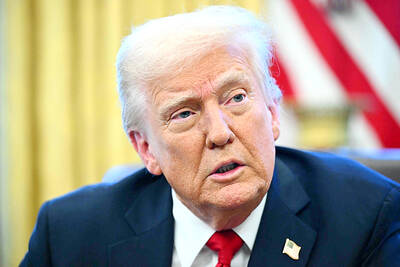The US risked inflaming a row on multiple fronts with China on Thursday, saying the Dalai Lama would visit the White House this month despite Beijing’s fierce protests.
But as tensions built over US President Barack Obama’s planned welcome for Tibet’s spiritual leader, officials sought to douse a running row with Beijing, saying the two sides had common interests despite mounting disagreements.
White House spokesman Robert Gibbs was pressed by reporters to name the date when the Dalai Lama would make his long-expected White House visit.
“He will be here later this month,” Gibbs said, but could not be more precise, adding that he did not know if the Dalai Lama would be granted the potent symbolism of an Oval Office visit with media availability.
US presidents have sometimes used a diplomatic tactic known as a “drop by” to see leaders or dignitaries likely to anger or embarrass key foreign powers, fitting in a visit in between scheduled talks between the visitor and another top official.
As China mounts fierce advance protests against the visit, Gibbs said Obama had informed Chinese President Hu Jintao (胡錦濤) when they met in Beijing in November that he would go ahead with the meeting.
Obama had declined to meet the Dalai Lama, who was in the US late last year, before going to China, in an apparent bid to get his ties with Beijing off on the right foot.
The Chinese government on Wednesday said it “resolutely opposes” the Dalai Lama’s visit to the US his meeting any US leaders.
“We urge the US side to clearly recognize the high sensitivity of the Tibet issue and handle related issues carefully and appropriately to avoid causing more harm to Sino-US ties,” Chinese foreign ministry spokesman Ma Zhaoxu (馬朝旭) said.
The Dalai Lama will visit Washington starting on Feb. 17, according to his office in India where the monk fled into exile in 1959.
The Dalai Lama said he was seeking greater rights for Tibetans under Chinese rule, but Beijing accuses him of separatism.
The US says it regards Tibet as part of China, but accuses Beijing of serious human rights abuses in the region.
Gibbs also sought to downplay the current back-and-forth between Beijing and Washington, adding that all the issues being aired publicly had been talked over in private between the two sides.
“There will be issues that we will disagree on, and we will disagree on them both in private and in public,” Gibbs said. “We envision this relationship as one where we can work together on issues of mutual concern. We’ve worked together on stabilizing the world economy. We’ve worked together on issues of proliferation, particularly around North Korea.”
David Shear, a State Department official who works on China, said the US would “regret” such reprisals, but noted that Beijing had not yet followed through on its threats.
“The Chinese reaction has been within expected parameters,” Shear said.

AGING: As of last month, people aged 65 or older accounted for 20.06 percent of the total population and the number of couples who got married fell by 18,685 from 2024 Taiwan has surpassed South Korea as the country least willing to have children, with an annual crude birthrate of 4.62 per 1,000 people, Ministry of the Interior data showed yesterday. The nation was previously ranked the second-lowest country in terms of total fertility rate, or the average number of children a woman has in her lifetime. However, South Korea’s fertility rate began to recover from 2023, with total fertility rate rising from 0.72 and estimated to reach 0.82 to 0.85 by last year, and the crude birthrate projected at 6.7 per 1,000 people. Japan’s crude birthrate was projected to fall below six,

Conflict with Taiwan could leave China with “massive economic disruption, catastrophic military losses, significant social unrest, and devastating sanctions,” a US think tank said in a report released on Monday. The German Marshall Fund released a report titled If China Attacks Taiwan: The Consequences for China of “Minor Conflict” and “Major War” Scenarios. The report details the “massive” economic, military, social and international costs to China in the event of a minor conflict or major war with Taiwan, estimating that the Chinese People’s Liberation Army (PLA) could sustain losses of more than half of its active-duty ground forces, including 100,000 troops. Understanding Chinese

US President Donald Trump in an interview with the New York Times published on Thursday said that “it’s up to” Chinese President Xi Jinping (習近平) what China does on Taiwan, but that he would be “very unhappy” with a change in the “status quo.” “He [Xi] considers it to be a part of China, and that’s up to him what he’s going to be doing, but I’ve expressed to him that I would be very unhappy if he did that, and I don’t think he’ll do that. I hope he doesn’t do that,” Trump said. Trump made the comments in the context

SELF-DEFENSE: Tokyo has accelerated its spending goal and its defense minister said the nation needs to discuss whether it should develop nuclear-powered submarines China is ramping up objections to what it sees as Japan’s desire to acquire nuclear weapons, despite Tokyo’s longstanding renunciation of such arms, deepening another fissure in the two neighbors’ increasingly tense ties. In what appears to be a concerted effort, China’s foreign and defense ministries issued statements on Thursday condemning alleged remilitarism efforts by Tokyo. The remarks came as two of the country’s top think tanks jointly issued a 29-page report framing actions by “right-wing forces” in Japan as posing a “serious threat” to world peace. While that report did not define “right-wing forces,” the Chinese Ministry of Foreign Affairs was